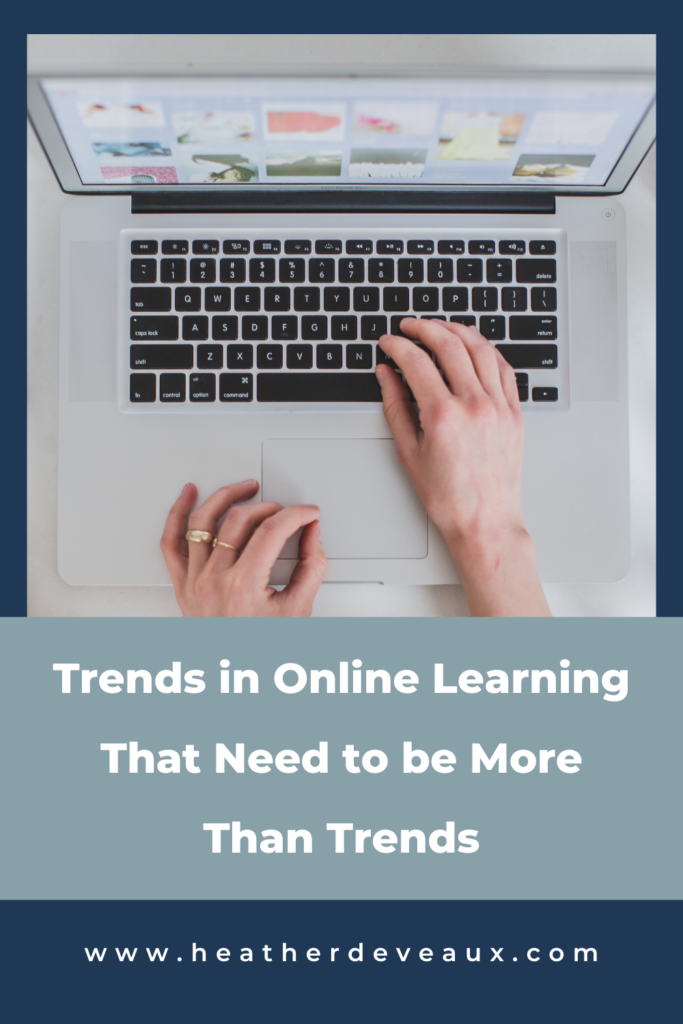Online Learning Trends You Can’t Ignore Right Now
In my constant effort to stay on top of what is happening in the online learning space, I recently came across an article citing the top ten trends in online education. Lists like these are quite popular. Especially for new instructional designers, curriculum developers, and anyone still trying to play catch-up in the online learning space. But one “trend” that is not mentioned, however, needs to be addressed.
In this article, we’ll explore this “trend” and explain why it’s here to stay. That is if you want the online learning experience to be successful for your students.
When a Trend is Not a Trend at All in Online Learning
There’s a lot of talk about artificial intelligence right now. It’s everywhere. Or at least, it feels like it is. Many tech start-ups are drooling at the idea of how to incorporate AI into the business world. Educators are also asking these questions. How can we use AI to make better learning experiences for our students?
But this article isn’t going to talk about AI. Technology has a long way to go before it can be effectively adopted, used, and measured from an education perspective, to be sure. What I want to talk about instead is the fact that technology can make it difficult for learners. Students need to ground themselves in the learning experience. Online learning creators already struggle to create opportunities for learning transformation to occur sometimes. We rely on the same old tricks of the trade to try to simulate or improve upon a classroom setting. But a trend that isn’t a trend at all still needs to be practiced. We still need to ground the student in their learning experience.

It’s important to help create opportunities for students to see themselves in what they are going to learn. In an effort to create inclusive spaces, students now have to ask “how can this information helps me interact with others?”
Through the Looking Glass of Online Learning
We tend to look at the world through our own set of glasses, sometimes literally. And that lens can often be blurred. In fact, more often than not, it is blurred, by our personal experiences, education, culture, and bias – unconscious or otherwise. When creating online learning experiences, instructional designers have the responsibility to consider how to mix technology with inclusive practices. But what gets missed, is creating the opportunity for students to come to the learning with an inclusive approach.
Consider how to help students ground their learning experiences with inclusive approaches. It’s important to help students understand how they, themselves feel when they can’t place their own beliefs or traditions.
Here’s an example. A unique learning activity may include asking a student to remember a time when they started a new job. They don’t know the company culture. And they aren’t aware of all of the processes to follow in order to make a request. Instead of going through the right channels, they may find themselves ducking into a colleague’s office to interrupt them, asking for help. It’s a classic fish-out-of-water situation and we’ve all been there at least once in our lives.
Next, ask the student to consider what helped them adopt the culture or become fluent in how to navigate it. Inclusion is not about getting everyone to be the same, but about creating pathways for people to get the same results, regardless of how they come to the situation. When we remember a time when we struggled to find a way forward, it becomes easier to imagine solutions that can be created for others to move forward.
Opportunities and Threats
As we move into this new era of online learning trends, there will no doubt be plenty of room for AI to take hold and be used. And it will surely be fun. But if as course creators we get lost in learning yet another piece of technology that tries to make our job easier, we could lose sight of what really matters: making sure our students learn something. When we spend too much time focusing on keeping up with the technology Jonses’, as it were, we lose the ability to connect with out students and that’s when education suffers.
I’m not saying don’t fiddle with AI and don’t continue to build your technology skills – I’m doing it all the time. But what I am saying is not to let it take over the goal: creating transformation for the student and ensuring that transformations we create from here on out are focused on also creating inclusive environments.
Because AI will come and go, like a lot of online learning trends. But we’re all in this together.







